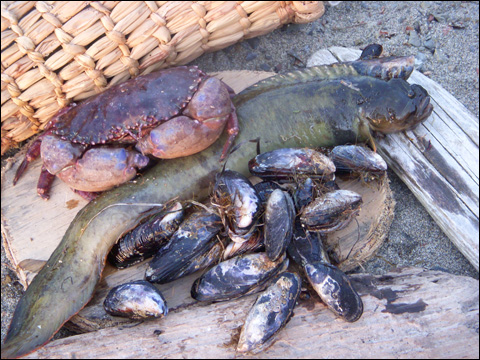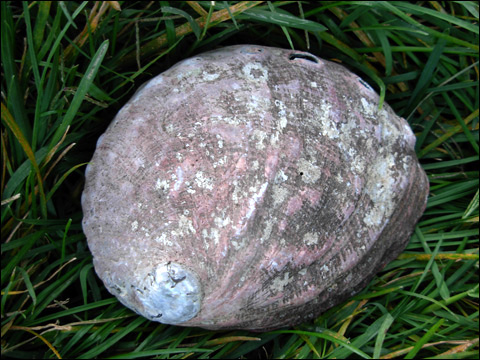
SEAFOOD AND AQUATIC RESOURCES

Shellfish: Shellfish were a staple food for Ohlone and for Coast (Bay) Miwok (Jacknis 2004:200), (Heizer & Elsasser 1980:91). A modified digging stick was used for most shellfish gathering, or they were gathered by hand (Jacknis 2004:186, 201). The use of a specialized tool similar to a digging stick was in use along the entire west coast of California (Jacknis 2004:189).
Paralytic shellfish poisoning was known by Native Peoples, but it’s incidence is not well recorded. Native Peoples accurately associated it with summer months, and ocean mussels (Heizer & Elsasser 1980:129). The Yokut Peoples traveled to the coast (probably through Ohlone territory) to gather shellfish (Jacknis 2004:182). Northern Pomo Peoples made 4-5 day trips to the coast to gather and dry shellfish, fish and seaweed (Jacknis 2004:196 Loeb 1926:192). Fresh shellfish were commonly roasted in hot coals and dried shellfish were commonly stone-boiled in baskets (California Indians) (Jacknis 2004:196), (Jacknis 2004:196 from Driver 1939:315, 381; Drucker 1937:234).
Abalone - Black abalone (Haliotis cracherodii), Red abalone (Haliotis rufenscens): Abalone are large, flattened snails which adhere tightly to the rocks. A strong sharpened hardwood stick similar to those used to pry off mussels was used to remove abalone from the rock in one quick motion. A clumsy attempt allows the mollusk to clamp down on the tool, making it impossible to remove the shell, and difficult to extract the stick (Jacknis 2004:188). At Bodega Bay, this was a dangerous activity. One has to search for abalone by feeling under large boulders at low tide. If the abalone clamps down on the searcher’s fingers, it can trap him there as the tide comes in (Jacknis 2004:188 from Kelley ms.:sec 2:32). The Wappo visited the coast to gather abalone. They also used sticks, or simply crushed the shell with a rock and removed the meat without having to pry it off (Jacknis 2004:189 from Driver 1936:84). To crush a shell, one would have to find the abalone on the exposed surface of a rock. These days it is unusual to find one in plain view.
Abalone provides an excellent food (author). The shell was used for jewelry and as a trade item by the Ohlone (Bean 1994:249-263).

Red abalone
Chitons - Gum boot chiton (Criptochiton stelleri): Chiton is listed as a food resource for the central coast (Heizer & Elsasser 1980:91). Pomo boiled them, removed the shell and dried them in the sun for a week. When one wanted to eat them, they were boiled, then sliced (Jacknis 2004:196).
Leather chiton (Katharina tunicata): This shellfish is listed (Heizer & Elsasser 1980:91).
Clams - Washington clam (Saxidomus nuttalli), Bent nosed clam (Macoma nasuta) - widely used in San Francisco Bay, Pismo clam (Tivela sultorum) - Monterey, Long neck clam (probably Schizothaerus nuttallii): Coast Miwok at Bodega Bay inserted a stick in siphon holes at low tide to locate the shell. These shells were less than an elbow’s depth below the surface and both men and women dug them. “Then go with fingers” (Jacknis 2004:185 from Kelly ms.:sec.2:31). A similar method is described for the Wappo (Jacknis 2004:185 from Driver 1936:184). From my own personal experience in digging clams at Tomales and Bodega Bays, a stick can be used to judge the depth of the clam. Most clams are located at greater than elbow depth, and deep clams are difficult to dig. One might choose to only pursue those near the surface. I have tried using a method described to me by a local resident in which one thrusts ones hand down the siphon hole to grasp and remove a clam. This took some effort as the siphon hole was considerably smaller than my hand and the clam was larger than the hole made by my arm. However, I did obtain several clams this way (author’s experience).
Rock clam (Saxidomus nuttallii): This form of Saxidomus clam is located in the rocks and a stick is needed to dig them out. They were prized for their thicker shell used for disc beads (Jacknis 2004:187 from Kelly ms.:sec. 2:30). This clam is the same species as the Washington clam. The habitat is apparently key to its shell thickness (author).
Freshwater clams are recorded as a food resource for other groups, including the Chenut and Wowol Yokuts, who cooked them by creating a 4-5 inch layer of tule, tightly packing clams on top with hinge side up so they couldn’t roll, then covering clams with tule. The tule was ignited and the heat steamed the clams open, their own liquid producing much of the steam (Jacknis 2004:197 from Latta 1949:253).
California oyster (Ostrea lurida): Abundant in San Francisco Bay and Tomales Bay (Heizer & Elsasser 1980:91). Coast Miwok used a digging stick to gather oysters (Jacknis 2004:185 from Nomland 1935:154).
Mussels: Father Juan Crespi makes note of the large numbers of mussel shell seen in Ohlone village sites during the 1774 expedition (Bean 1994:19). Mussels were eaten by the Ohlone Peoples (Jacknis 2004:194 from Kroeber 1925:467). The Ohlone dried foods in the sun and sometimes used smoke, but their specific preservation treatment of mussels is inferred (Jacknis 2004: 194).
California mussel (Mytilus californianus) (Heizer & Elsasser 1980:91): Coast Miwok men of Bodega Bay obtained this large sea mussel with a sharpened hardwood stick (Jacknis 2004:185 from Kelly ms.:T-2, 15b). The Pomo boiled or roasted the mussels on hot coals. They were then sun dried on hazel sticks. The sticks were arranged like spokes on a wheel and taken home in burden baskets. Later, they were eaten dry like jerky (Jacknis 2004:194 from Gifford 1939:315). Greengo reports these dried mussels were soaked in fresh water until swollen, then cooked before eating (Jacknis 2004:194 from Greengo ms.:10).
Blue or Bay mussel (Myelus edulus): This mussel is listed as a food resource for the central coast (Heizer & Elsasser 1980:91).
Horse barnacle (Mitella polymerus): This barnacle is listed as a food resource for the central coast (Heizer & Elsasser 1980:91). The Pomo built a fire around a bed of barnacles exposed at low tide. The incoming tide put out the fire, and the barnacles were eaten the next day when they were again exposed. Pomo also removed barnacles and cooked them in hot ashes (Jacknis 2004:185 from Loeb 1926:164).
Sea anenome (Cribrina xanthogrammica): It were roasted in ashes or coals by the Nothern Pomo, Coast Yuki and the Tolowa, and perhaps the Wiyot (Jacknis 2004:199 from Stewart 1943:60, Gifford 1939:328, Greengo ms.:13).
Purple sea urchin (Strngylocentrotus pupuratus): Yellow egg mass eaten raw (Heizer & Elsasser 1980:91). The egg masses are only available April to June (Jacknis 2004:192 from Jochelson 1925:106). Today, urchin’s eggs are gathered commercially for export to Japan (author).
Crabs (Cancer antenarius and Cancer productus): These two species can be found along rocky coastlines and were the only two species considered important as a food (Jacknis 2004:190 from Rickets and Calvin 1948:80ff). Basket traps were utilized by some groups. Crabs were also gathered by hand (Jacknis 2004:201). Pomo lured the crab to a hand net with the use of baited line (Jacknis 2004:191 from Loeb 1926:165). Yurok, Wyote and Hupa employed a variety of cooking methods. They either boiled them in baskets, roasted them over a fire or baked them in hot sand. Similar methods were used for other shellfish (Jacknis 2004:197).
Fish
Yokut and Pomo peoples used “fish poison” to secure freshwater fish in streams. Spears, seins and gillnets were used by most groups. Hooks were less commonly used, especially in the San Francisco Bay, but were apparently known to most groups (Jacknis 2004:130-131). Many kinds of fish were available, but salmon are central to many California Native Peoples. North of Monterey, fresh water streams supported salmon runs (Heizer & Elsasser 1980:85). The first Spanish explorers of 1769 noted the extensive use of fish traps by Ohlone to capture large numbers of small fish in a stream (Bean, 1994:7).
Salmon: Chinook salmon weighed 16 to 70 pounds. They spawned in the fall (Jacknis 2004:176). Salmon roe (eggs) were also cook or dried and eaten by the Southern Miwok (Jacknis 2004:179). Every Native group used spears, nets and weirs to secure salmon (Heizer & Elsasser 1980:85).
Surf smelt (Sperinchus starksi) and (Allosmorus attenuatus): Surf smelt were caught. Both occur within Ohlone territory (Jacknis 2004:194 from Roedel 1948:41) and were noted in the July 1774 diary of Father Serra as they were gathered by the Ohlone on an excursion to the Coast (Bean 1984:184 from Serra 1748-84/1955-56:2:142).
Nets: Gill nets, the seine for surrounding fish, and dip nets were known to all California Indians, but they were not all employed by each group (Jacknis 2004:131). I found no reference to how the Ohlone used their nets (author).
Fish remains found in Ohlone archaeological sites included: Splittail, hitch, thicktail chub, minnow, Sacramento sucker, steelhead, Pacific herring, Pacific sardine, rockfish and shark (Bean 1994:263). This is not an all inclusive list.
Periwinkle: Evidence of their use by Ohlone is seen in the large numbers of these shells found in Bay Area middens (shell mounds) (author after viewing debris at Coyote Hills Regional Park, 2007).
Olivella shells (Olivella biplicata): This species was not eaten. It was gathered to be used as a bead. This popular shell was also a trade item (Heizer & Elsasser 1980:91). Modern archaeologists find both the shell and beads made from the shell. They use the number of these shells as one way to measure the wealth of the inhabitants (Bean 1994:259).
Seaweed
Seaweed, both purple seaweed and sea lettuce, was used fresh to wrap seafood. It kept it moist and cool and prevented spoilage. Seaweed could be dried and eaten whole or pounded into a flour (Bocek 1984:247).
Purple seaweed (Porphyra perforata): This edible seaweed is related to Japan’s nori. Native Peoples (no cultural group indicated) dried it into cakes and nibbled it at meals as a salt source and condiment (Heizer & Elsasser 1980:108).
Sea lettuce (Ulva) and Red seaweed (Porphyra): Ohlone collected it in rocky intertidal zones and used it to keep seafood fresh. It was also dried and eaten, either whole or as a pounded flour (Bocek 1984:247).
![]()
Photographs by Susan Labiste. All photo rights reserved.
We hope the information on the PrimitiveWays website is both instructional and enjoyable. Understand that no warranty or guarantee is included. We expect adults to act responsibly and children to be supervised by a responsible adult. If you use the information on this site to create your own projects or if you try techniques described on PrimitiveWays, behave in accordance with applicable laws, and think about the sustainability of natural resources. Using tools or techniques described on PrimitiveWays can be dangerous with exposure to heavy, sharp or pointed objects, fire, stone tools and hazards present in outdoor settings. Without proper care and caution, or if done incorrectly, there is a risk of property damage, personal injury or even death. So, be advised: Anyone using any information provided on the PrimitiveWays website assumes responsibility for using proper care and caution to protect property, the life, health and safety of himself or herself and all others. He or she expressly assumes all risk of harm or damage to all persons or property proximately caused by the use of this information.
© PrimitiveWays 2016